What We’re Reading: June 9th
This week’s What We’re Reading is curated by Sridhar Gutam, Senior Scientist, Indian Council of Agricultural Research and Nidhi Sharma, Research Specialist, Stanford University.

Nidhi Sharma is a researcher in Dominique Bergmann’s lab at Stanford University. She graduated from The University of Texas at Austin and did post-doctoral work with Dr. Kathy Barton at Carnegie Institution of Science. Other than plants, she is passionate about traveling and crafting.
Sridhar Gutam currently working as scientist at the ICAR-Indian Institute of Horticultural Research, Bengaluru, India as Plant Physiologist. His interests are phenology of fruit tree crops and open access to agricultural data and information.
Review: Zooming in on plant hormone analysis: Tissue- and cell-specific approaches ($)
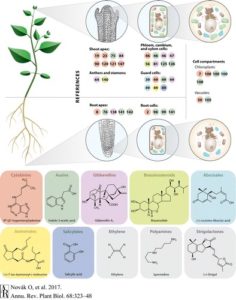 Throughout plant life cycle, from germination till reproduction, every event is regulated by a highly complex network of hormones. Unlike animals where hormones are synthesized in specific glands, each plant cell is able to produce hormones. However, hormones are synthesized in specific organs in plants. Recent advancements in tools have enabled plant scientists to study distribution profiles of phytohormones in plants. Read more about these cool tools in this review by Novák et al. (Summary by Nidhi Sharma) Annu. Rev. Plant Biol. 10.1146/annurev-arplant-042916-040812
Throughout plant life cycle, from germination till reproduction, every event is regulated by a highly complex network of hormones. Unlike animals where hormones are synthesized in specific glands, each plant cell is able to produce hormones. However, hormones are synthesized in specific organs in plants. Recent advancements in tools have enabled plant scientists to study distribution profiles of phytohormones in plants. Read more about these cool tools in this review by Novák et al. (Summary by Nidhi Sharma) Annu. Rev. Plant Biol. 10.1146/annurev-arplant-042916-040812
Melatonin regulates leaf development by suppressing cell proliferation and endoreduplication
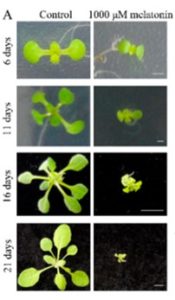 Melatonin plays various roles in animals such as sleep, circadian rhythms, body temperature regulation, immune responses, etc. In plants, Melatonin functions as a messenger in plant growth (root and shoot development, flowering, seed germination and fruit ripening) and stress response (temperature, drought, pathogen attacks, etc.). In order to investigate underlying mechanism of leaf growth regulation by Melatonin, Wang et al treated Arabidopsis leaves to varying concentration of Melatonin. Their findings suggest high concentration of Melatonin suppresses leaf growth in Arabidopsis by reducing both cell size due to decreased endoreduplication and cell number due to decreased cell division rate. (Summary by Nidhi Sharma) Int. J. Mol. Sci. 10.3390/ijms18050991
Melatonin plays various roles in animals such as sleep, circadian rhythms, body temperature regulation, immune responses, etc. In plants, Melatonin functions as a messenger in plant growth (root and shoot development, flowering, seed germination and fruit ripening) and stress response (temperature, drought, pathogen attacks, etc.). In order to investigate underlying mechanism of leaf growth regulation by Melatonin, Wang et al treated Arabidopsis leaves to varying concentration of Melatonin. Their findings suggest high concentration of Melatonin suppresses leaf growth in Arabidopsis by reducing both cell size due to decreased endoreduplication and cell number due to decreased cell division rate. (Summary by Nidhi Sharma) Int. J. Mol. Sci. 10.3390/ijms18050991
The composition of the Arabidopsis RNA Polymerase II Transcript Elongation Complex reveals the interplay between elongation and mRNA processing factors
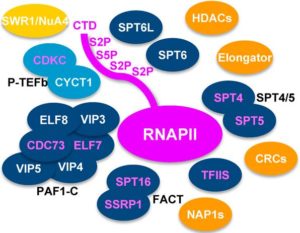 Gene expression is regulated at multiple levels such as genome, transcription, RNA processing and nuclear export, translation, and post-translation. Functional mRNA levels are regulated at transcription stage where RNA polymerase II (RNAPII) controls initiation and elongation of mRNA. In particular, the C-terminal domain of RNAPII defines the elongation phase along with Transcript Elongation Factors (TEFs). Using Reciprocal Tagging approach, Antosz et al identified TEFs in Arabidopsis RNAPII elongation complex. They also studied epistatic interaction between the TEF genes and their effects on plant growth and development. In addition, they co-purified several splicing proteins with TEF-RNAPII complex suggesting interplay between mRNA elongation and processing at the same time. (Summary by Nidhi Sharma) Plant Cell
Gene expression is regulated at multiple levels such as genome, transcription, RNA processing and nuclear export, translation, and post-translation. Functional mRNA levels are regulated at transcription stage where RNA polymerase II (RNAPII) controls initiation and elongation of mRNA. In particular, the C-terminal domain of RNAPII defines the elongation phase along with Transcript Elongation Factors (TEFs). Using Reciprocal Tagging approach, Antosz et al identified TEFs in Arabidopsis RNAPII elongation complex. They also studied epistatic interaction between the TEF genes and their effects on plant growth and development. In addition, they co-purified several splicing proteins with TEF-RNAPII complex suggesting interplay between mRNA elongation and processing at the same time. (Summary by Nidhi Sharma) Plant Cell
A Plant Cryptochrome Controls Key Features of the Chlamydomonas Circadian Clock and Its Life Cycle
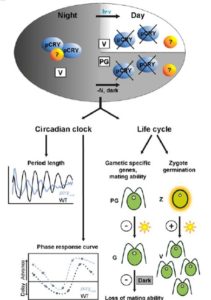 Animals and plants have divergent sets of blue light receptors, called Cryptochromes. However, green alga Chlamydomonas has both animal-like and plant cryptochrome (pCRY). The presence of multiple cryptochrome suggests specific roles in different pathways in respective organisms. In this paper, Müller et al explore the biological functions of pCRY using a mutant with reduced pCRY activity. pcry mutant showed defects in circadian clock with longer period and phase shifts. pcry also show differential expression profile during the life cycle. (Summary by Nidhi Sharma) Plant Physiol.
Animals and plants have divergent sets of blue light receptors, called Cryptochromes. However, green alga Chlamydomonas has both animal-like and plant cryptochrome (pCRY). The presence of multiple cryptochrome suggests specific roles in different pathways in respective organisms. In this paper, Müller et al explore the biological functions of pCRY using a mutant with reduced pCRY activity. pcry mutant showed defects in circadian clock with longer period and phase shifts. pcry also show differential expression profile during the life cycle. (Summary by Nidhi Sharma) Plant Physiol.
Elevated temperature drives a shift from selfing to outcrossing in the insect-pollinated legume, faba bean (Vicia faba)
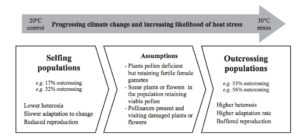 The effects of climate change on agriculture to human health have been well discussed in both scientific and public domains. In plants, changes in climate might affect interactions between the plants and their insect pollinators due to variable availability of pollinators in severe weather conditions, thus affecting reproductive success of plants and crop yield. In this paper, Bishop et al investigate how plant–pollinator interactions are modified by extreme weather by subjecting faba bean (Vicia faba) to altered temperature. Read the paper to see how they quantified pollen movement between plants using a unique phenotypic marker. (Summary by Nidhi Sharma) J. Exp. Bot. 10.1093/jxb/erw430
The effects of climate change on agriculture to human health have been well discussed in both scientific and public domains. In plants, changes in climate might affect interactions between the plants and their insect pollinators due to variable availability of pollinators in severe weather conditions, thus affecting reproductive success of plants and crop yield. In this paper, Bishop et al investigate how plant–pollinator interactions are modified by extreme weather by subjecting faba bean (Vicia faba) to altered temperature. Read the paper to see how they quantified pollen movement between plants using a unique phenotypic marker. (Summary by Nidhi Sharma) J. Exp. Bot. 10.1093/jxb/erw430
TAL effector driven induction of a SWEET gene confers susceptibility to bacterial blight of cotton
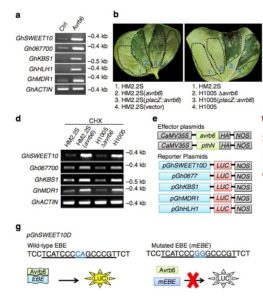 Plants undergo photosynthesis in leaves to produce carbohydrates sucrose and starch. The sucrose is transported to other parts of the plants via sugar transporters called SWEET proteins. In addition, certain plant pathogens activate SWEET genes to invade their host. As shown in this paper, during bacterial blight of cotton (BBC) disease, in cotton GhSWEET10 is induced by Transcription activator-like (TAL) Avrb6 from Xanthomonas citri subsp. malvacearum (Xcm). Understanding this mechanism of infection during BBC would help us develop pathogen resistant varieties of cotton. (Summary by Nidhi Sharma) Nature Comms. 10.1038/ncomms15588
Plants undergo photosynthesis in leaves to produce carbohydrates sucrose and starch. The sucrose is transported to other parts of the plants via sugar transporters called SWEET proteins. In addition, certain plant pathogens activate SWEET genes to invade their host. As shown in this paper, during bacterial blight of cotton (BBC) disease, in cotton GhSWEET10 is induced by Transcription activator-like (TAL) Avrb6 from Xanthomonas citri subsp. malvacearum (Xcm). Understanding this mechanism of infection during BBC would help us develop pathogen resistant varieties of cotton. (Summary by Nidhi Sharma) Nature Comms. 10.1038/ncomms15588
Variable mesophyll conductance among soybean cultivars sets a tradeoff between photosynthesis and water-use-efficiency
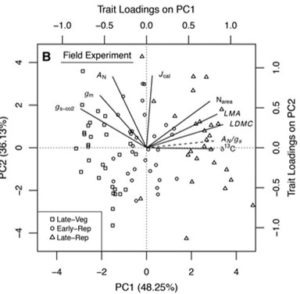 An experimental study by Tomeo and Rosenthal with soybean cultivars demonstrated that there exists genotypic differences in mesophyll conductance (gm), and that the potential exploitation of this trait may increase crop productivity. It was found that there exists a proper coordination mechanism between gm and the physiology of leaf photosynthesis. The gm which alters the CO2 concentration in the leaf photosynthesis apparatus was found to be independent of water loss from the leaf and the exploitation of this trait in selecting genotypes which have higher gm will help in developing improved productive and climate resilient varieties. (Summary by Sridhar Gutam) Plant Physiol.
An experimental study by Tomeo and Rosenthal with soybean cultivars demonstrated that there exists genotypic differences in mesophyll conductance (gm), and that the potential exploitation of this trait may increase crop productivity. It was found that there exists a proper coordination mechanism between gm and the physiology of leaf photosynthesis. The gm which alters the CO2 concentration in the leaf photosynthesis apparatus was found to be independent of water loss from the leaf and the exploitation of this trait in selecting genotypes which have higher gm will help in developing improved productive and climate resilient varieties. (Summary by Sridhar Gutam) Plant Physiol.
For drought tolerance, is water use efficiency (WUE) no longer a recommended selection criteria for energy crops?
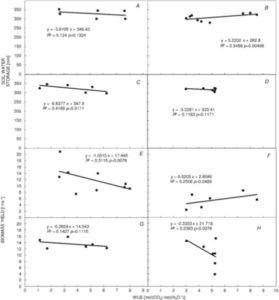 Podlaski et al. conducted experiments with energy crops like miscanthus, prairie cordgrass, willow, etc, and report that water use efficiency (WUE) is no longer a valid trait for selecting energy crops for drought tolerance. They could not find any significant relationship between WUE and biomass yield. However, they found a positive correlation between soil water storage and the biomass yield, and the response was highly differentiated among the crops under various vegetation seasons. (Summary by Sridhar Gutam) Photosynthetica 10.1007/s11099-017-0697-0
Podlaski et al. conducted experiments with energy crops like miscanthus, prairie cordgrass, willow, etc, and report that water use efficiency (WUE) is no longer a valid trait for selecting energy crops for drought tolerance. They could not find any significant relationship between WUE and biomass yield. However, they found a positive correlation between soil water storage and the biomass yield, and the response was highly differentiated among the crops under various vegetation seasons. (Summary by Sridhar Gutam) Photosynthetica 10.1007/s11099-017-0697-0
Root traits confer grain yield advantages under terminal drought in chickpea (Cicer arietinum L.)
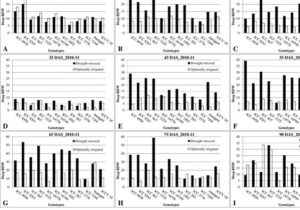 This study by Ramamoorthy et al. showed that survival of plants under drought conditions is not a sufficient goal for breeding. Rather, yield for biomass and food production under water deficit is a better target. Chickpea genotypes having better root growth and higher root density showed better grain filling, and produced good yields in these studies. Some of the genotypes showed proper grain filling with better partition of photosynthates because of higher root density at deeper layers and higher root length at surface. (Summary by Sridhar Gutam) Field Crops Res. 10.1016/j.fcr.2016.11.004
This study by Ramamoorthy et al. showed that survival of plants under drought conditions is not a sufficient goal for breeding. Rather, yield for biomass and food production under water deficit is a better target. Chickpea genotypes having better root growth and higher root density showed better grain filling, and produced good yields in these studies. Some of the genotypes showed proper grain filling with better partition of photosynthates because of higher root density at deeper layers and higher root length at surface. (Summary by Sridhar Gutam) Field Crops Res. 10.1016/j.fcr.2016.11.004
Interrupting long nights by short pulses of light accelerates flowering in wheat
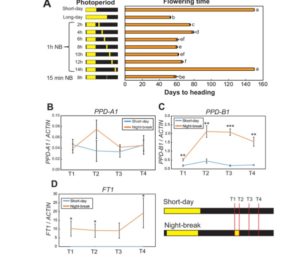 In order to address the knowledge gap in the mechanisms of photoperiodic induction of flowering by phytochrome, Pearce et al. studied flowering behavior in wheat grown under short days, with the interruption of the long nights by short pluses of light (night breaks). Their study showed that night breaks accelerate flowering, and also demonstrated that the response is mediated by photoperiod and phytochrome and requires both PHYB and PHYC. Night breaks affect the expression of PHOTOPERIOD1 (PPD1), which affects the expression of the flowering promoter FT1. (Summary by Sridhar Gutam) Plant Physiol. 10.1104/pp.17.00361
In order to address the knowledge gap in the mechanisms of photoperiodic induction of flowering by phytochrome, Pearce et al. studied flowering behavior in wheat grown under short days, with the interruption of the long nights by short pluses of light (night breaks). Their study showed that night breaks accelerate flowering, and also demonstrated that the response is mediated by photoperiod and phytochrome and requires both PHYB and PHYC. Night breaks affect the expression of PHOTOPERIOD1 (PPD1), which affects the expression of the flowering promoter FT1. (Summary by Sridhar Gutam) Plant Physiol. 10.1104/pp.17.00361
Harnessing the hidden genetic diversity for improving multiple abiotic stress tolerance in rice
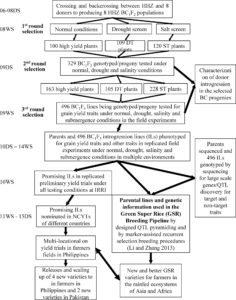 Ali et al. describe a rice breeding strategy to improve abiotic stress tolerance as well as to accelerate the speed to achieving homozygosity. The researchers named this particular technique as “Green Super Rice” (GSR) breeding technology. They use a backcross (BC) breeding approach to fix breeding lines which are tolerant of multiple abiotic stresses and also perform well under normal irrigated conditions to generate large set of improved and tolerant lines to abiotic and biotic stresses (introgression lines). Data from several lines grown in the field are described. (Summary by Sridhar Gutam) PLoS One. 10.1371/journal.pone.0172515
Ali et al. describe a rice breeding strategy to improve abiotic stress tolerance as well as to accelerate the speed to achieving homozygosity. The researchers named this particular technique as “Green Super Rice” (GSR) breeding technology. They use a backcross (BC) breeding approach to fix breeding lines which are tolerant of multiple abiotic stresses and also perform well under normal irrigated conditions to generate large set of improved and tolerant lines to abiotic and biotic stresses (introgression lines). Data from several lines grown in the field are described. (Summary by Sridhar Gutam) PLoS One. 10.1371/journal.pone.0172515
For the remainder of June and July, several Plantae Fellows will take turns editing the What We’re Reading series. The Plantae Fellows were selected for their interest in communicating science, and they are looking forward to wearing the Editor hat and sharing their selections with you in the coming weeks. (Note – if you are interested in applying to be a 2017-2018 Plantae Fellow, we will be issuing an application call in the next few days. Watch this space!)
Future Weekly “What We’re Reading” Guest Editors
June 16 Sudhakar Srivastava, Postdoctoral Fellow at Blaustein Institute for Desert Research, Ben-Gurion University, Israel
June 23 Gaby Auge, Senior Researcher at Fundación Insituto Leloir, IIBBA-CONICET, Argentina
July 30 Mather Khan, Postdoctoral Fellow, University of Missouri
July 7 KK Sabu, Senior Scientist, Jawaharlal Nehru Tropical Botanic Garden and Research Institute, India
July 21 Khalid Hakeem, Associate Professor, King Abdulazis University, Saudi Arabia
July 28 Bhavisha Sheth, Postdoctoral Fellow, Policy Research in Science, Technology and Innovation, India



